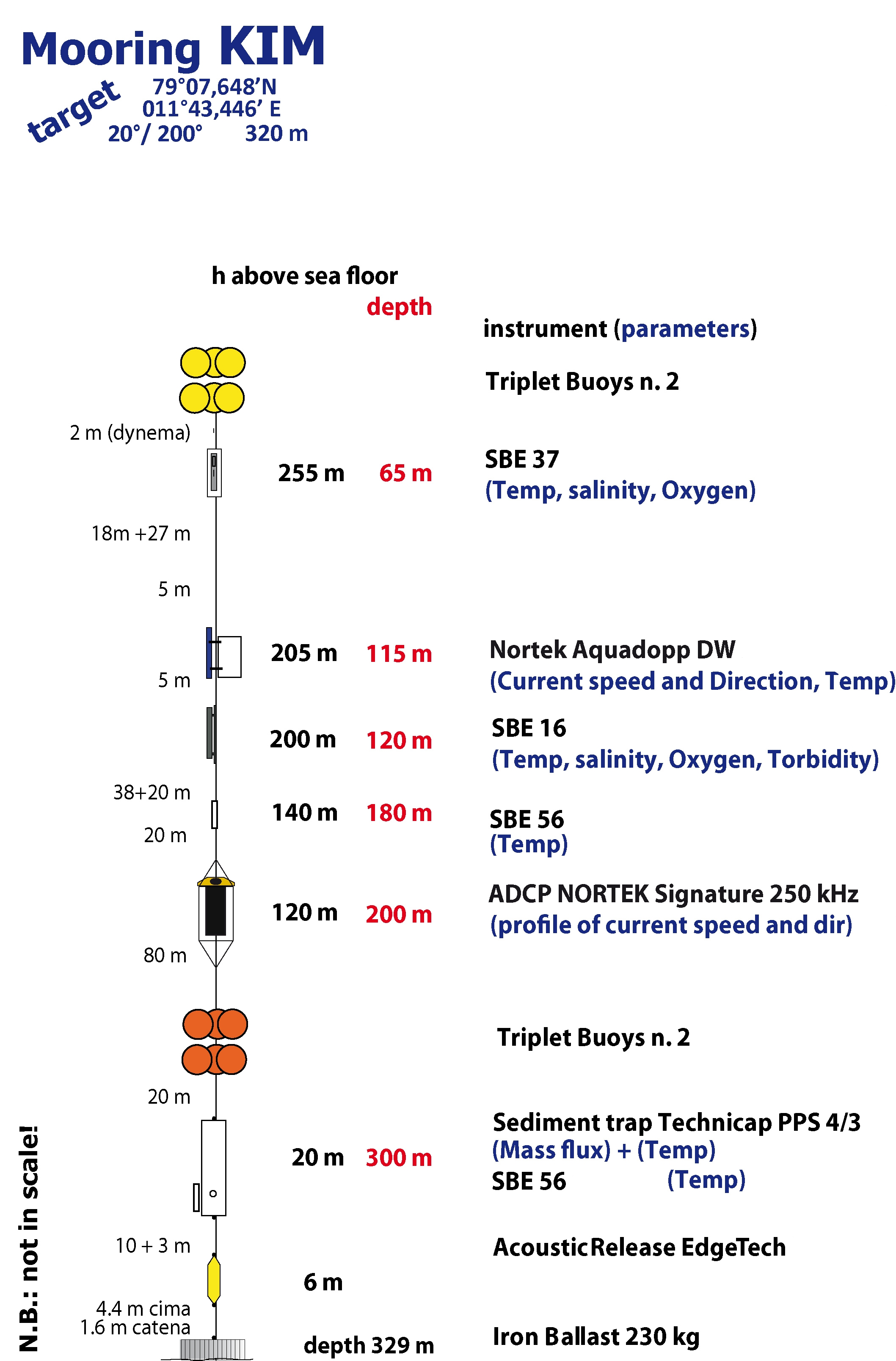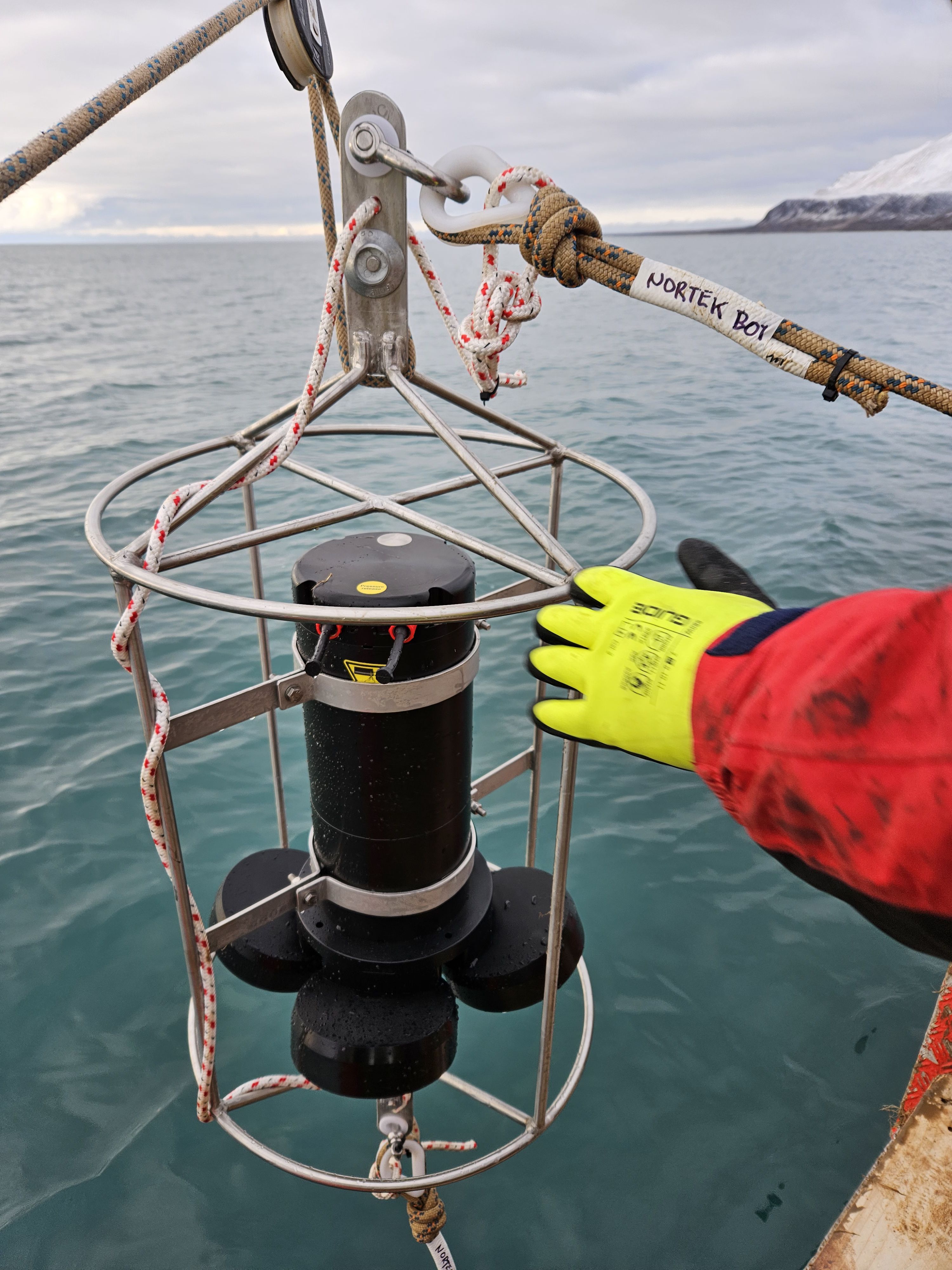1
Type of resources
Available actions
IADC Research Activities
Topics
Keywords
Contact for the resource
Provided by
Years
Formats
Representation types
Update frequencies
status
Scale
-

The Krossfjord Italian Mooring (KIM), operated by the Institute of Polar Sciences of the National Research Council (CNR), has been active in the Krossfjord of the Svalbard archipelago since September 9, 2020. The mooring line is equipped with various instruments placed at depths ranging from 65 to 300 meters in the water column. These instruments collect a wide range of physical and biogeochemical Essential Ocean Variables, including seawater pressure, temperature, conductivity, currents, dissolved oxygen concentration, turbidity, particle fluxes and ocean sound. This activity is part of the SIOS (Svalbard Integrated Arctic Earth Observing System), designed to monitor the impacts of climate change, such as the rapid loss of sea ice cover, the retreat of local glaciers, and the Atlantification of Arctic seas. Time series acquisition is ongoing and will continue, supported by the integration of this infrastructure into the Italian Marine Data Portal, developed under the ITINERIS PNRR project. This project also funds the enhancement of the research infrastructure with new sensors to improve measurement resolution, expand the number of EOVs measured, and support the continuous collection of long-term data. These efforts will further deepen our understanding of the observed environmental changes.
-

Continuous Vis-Near IR Characterization of snow-ice surface in Ny-Ålesund (SnowIceCReM) The activity foreseen for 2015-2020 includes: continuous full-range reflectance measurements; continuous multispectral observations; ground-truth survey on snow surfaces. The first part of the activity is attempted to replicate the experiment carried out in 2014 where a VNIR spectroradiometer were deployed at the CCT. Hardware upgrades will be coupled with the addition of some position and optical reference targets. An hemispheric webcam will acquire high resolution sky and ground images to support the experiment in terms of cloud and snow cover/roughness characterization, and to provide a quality check of the rotating support position by means of the above mentioned specific targets. The availability of such accessory information will help on selecting a homogeneous spectral albedo dataset. The same quality check approach will be used also for the deployment of a second instrument that will be developed in order to obtain fixed band albedo at 860, 1240 and 1640 nm. Both measurements will be hemispheric, in the 350-2500nm wavelength range. While the first set up obtains asynchronous spectral albedo, the second one provides synchronous spectral albedo on bands selected considering sensors deployed on satellites. The final task will be persecuted with a ground-truth survey focused on calibrating the two different hemispherical receivers with bidirectional observations.
-
The Climate Change Tower Integrated Project (CCT-IP) represents the guide lines of the italian research in the arctic and aims to study the interaction between all the components of the climate system in the Arctic. The Amundsen-Nobile Climate Change Tower (CCT) is the key infrastructure of the project, and provides continuous acquisition of the atmospheric parameters at different heights as well as at the interface between the surface and the atmosphere. Images of the sky are taken every 15 minutes and are available under request.
-

A long-term climate manipulation experiment has been ongoing since 2014 at the REMUS site (Responses of Microbes in Upper Soil Horizons to Environmental Manipulations). Twenty-four open-top chambers (OTCs) were installed to simulate warmer ground temperatures and increased precipitation. To mimic enhanced rainfall, irrigation is applied twice a year, at the end of June and August. The transparent OTCs create an average ground temperature increase of approximately 1°C in the treated plots. The site is located about 11 Km from Ny-Ålesund at Kongsfjordneset (78.96661°N 11.47576°E) on the Brøgger Peninsula. In total, 48 plots with different plant species have been selected for the study. Of these, 24 are equipped with OTCs, while the remaining 24 are irrigated, with half of the irrigated plots also containing OTCs (12 with OTCs, 12 without). The REMUS site is registered on the Research in Svalbard Portal under ID 6921. This site is part of the International Tundra Experiment (ITEX), a global research initiative aimed at understanding the responses of tundra plant species through simple manipulation and transplant experiments conducted across multiple Arctic and alpine sites.
-

Ice Nuclei Particle Concentration (INP) Ice nucleating particle (INPs) concentration obtained in spring and summer campaigns in the Arctic Region. Sampling lines allow the aerosol particles collection onto the filters and the sampling line for the continuos measurements of size distribution with the OPC and SMPS. The aim is to improve our understanding of aerosol-cloud-climate interactions and representation of climate models.
-
Snow sampling every year at the Kongsvegen glacier, in Svalbard
-
Mixing state and organic volume fractions of sub micron aerosol particles collected at the Zeppelin observatory
-

This dataset comprises measurements from a moored Acoustic Doppler Current Profiler (ADCP), collected by the Krossfjord Italian Mooring (KIM), which is managed by the Institute of Polar Sciences of the National Research Council (CNR). The data was gathered in the Krossfjord, Svalbard Island, since September 2020. This dataset come from a new sensor acquired in the context of the Italian PNRR project ITINERIS with the aim to increase observation of essential ocean variables. This dataset contribute to the SIOS-Svalbard Integrated Arctic Earth Observing System, developed to observe the impacts of climate change, including the rapid loss of sea ice cover, the retreat of local glaciers, and the Atlantification of Arctic seas. Measured properties are: subsurface temperature and currents along the water column. This ensures sustained data collection and further enhances our understanding of the observed environmental changes.
-

Data refers to the CNR-IGG eddy covariance (EC) facility at the Arctic CZO (Critical Zone Observatory, hereafter CZO@Bayelva in Ny Ålesund). Data have been collected since 2019, all year long, with some interruptions due to ordinary or factory maintenance. The EC tower was installed to study CO2, H20, latent and sensible heat exchanges between soil, vegetation, and atmosphere. Carbon dioxide fluxes and environmental variables are recorded to estimate changes in carbon storage and explore CO2 fluxes drivers in the Arctic tundra. Measured parameters: Net vertical turbulent CO2 flux (umol+1s-1m-2); air temperature (deg_C), air relative humidity (%), wind speed (m+1s-1), max wind speed (m+1s-1), wind direction (deg_from_north). Method: The EC station respects both sensors and data processing standards defined by the ICOS community even if it is not an ICOS-associated station. Flux processing software: EddyPro set to default processing settings. The output variables have a 30-minutes resolution. The parameters available here are obtained by aggregating over a 3-hours time span. The associated measurement time (column B in the uploaded file) indicates the beginning of the 3-hour averaging period (es. Time T= [Time T; Time T+2h30 min]). Instrumentation: 3-Dimensional Sonic Anemometer (Manufacturer: Gill HS-50, s.n.: H183304, Firmware: 3.01, Instrument height: (info in the yearly metadata), North alignment: SPAR, North offset: (info in the yearly metadata), Wind data format: u, v, w); Enclosed path CO2/H2O Gas Analyzer (Licor Li7200RS, s.n.: 72H-0888, Firmware: (info in the yearly metadata), Tube length: 105.8 cm, Tube diameter: 5.33 mm, Northward separation: (info in the yearly metadata), Eastward separation: (info in the yearly metadata), Vertical separation: (info in the yearly metadata)). Quality assurance: Mauder and Foken (2004) flagging policy (0-1-2 system). Here, only high-quality data are reported (qc=0). The CNR-IGG Researchers took the photo of the eddy covariance during the field campaign.
-

Measurements are obtained using a Pyrgeometer Kipp&Zonen, model CGR4, installed at Thule Air Base (220 m a.s.l.) in May 2013. The instrument sensitivity was determined during factory calibration for temperatures down to -40 °C, thus specifically suited for the polar environment. Data are acquired by a datalogger at 30 s time intervals and then transferred to a PC. The CGR4 and its dedicated PC are maintained by Daniela Meloni at ENEA.